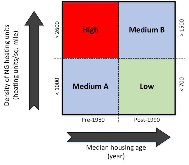Exploratory study of atmospheric methane enhancements derived from natural gas use in the Houston urban area
- Rice Univ., Houston, TX (United States)
- Rice Univ., Houston, TX (United States); Jilin Univ., Changchun (China)
- Rice Univ., Houston, TX (United States); Shantou Univ., Shantou (China)
Here, the extensive use of natural gas (NG) in urban areas for heating, cooking and as a vehicular fuel is associated with potentially significant emissions of methane (CH4) to the atmosphere. Methane, a potent greenhouse gas that influences the chemistry of the atmosphere, can be emitted from different sources including leakage from NG infrastructure, transportation activities, end-use uncombusted NG, landfills and livestock. Although significant CH4 leakage associated with aging local NG distribution systems in the U.S. has been reported, further investigation is required to study the role of this infrastructure component and other NG-related sources in atmospheric CH4 enhancements in urban centers. In this study, neighborhood-scale mobile-based monitoring of potential CH4 emissions associated with NG in the Greater Houston area (GHA) is reported. A novel dual-gas 3.337 μm interband cascade laser-based sensor system was developed and mobile-mode deployed for simultaneous CH4 and ethane (C2H6) monitoring during a period of over 14 days, corresponding to ~ 90 hours of effective data collection during summer 2016. The sampling campaign covered ~ 250 road miles and was primarily concentrated on eight residential zones with distinct infrastructure age and NG usage levels. A moderate number of elevated CH4 concentration events (37 episodes) with mixing ratios not exceeding 3.60 ppmv and associated with atmospheric background enhancements below 1.21 ppmv were observed during the field campaign. Source discrimination analyses based on the covariance between CH4 and C2H6 levels indicated the predominance of thermogenic sources (e.g., NG) in the elevated CH4 concentration episodes. The volumetric fraction of C2H6 in the sources associated with the thermogenic CH4 spikes varied between 2.7 and 5.9%, concurring with the C2H6 content in NG distributed in the GHA. Isolated CH4 peak events with significantly higher C2H6 enhancements (~11 %) were observed at industrial areas and locations with high density of petroleum and gas pipelines in the GHA, indicating potential variability in Houston’s thermogenic CH4 sources.
- Research Organization:
- Rice Univ., Houston, TX (United States)
- Sponsoring Organization:
- USDOE Advanced Research Projects Agency - Energy (ARPA-E)
- Grant/Contract Number:
- AR0000538
- OSTI ID:
- 1435611
- Report Number(s):
- DOE-MAXION-00538-13; PII: S1352231018300013
- Journal Information:
- Atmospheric Environment (1994), Vol. 176, Issue C; ISSN 1352-2310
- Publisher:
- ElsevierCopyright Statement
- Country of Publication:
- United States
- Language:
- English
Web of Science
A Lagrangian interpolation-assisted direct laser absorption spectrum analyzer based on digital signal processor for methane detection
|
journal | April 2019 |
Similar Records
Analysis of Oil and Gas Ethane and Methane Emissions in the Southcentral and Eastern United States Using Four Seasons of Continuous Aircraft Ethane Measurements
Using Multiscale Ethane/Methane Observations to Attribute Coal Mine Vent Emissions in the San Juan Basin From 2013 to 2021








